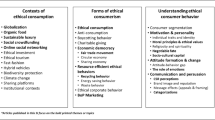Abstract
In this paper I consider some of the methodological issues involvedin designing valid contingent valuation (CV) scenarios. I identifythe several parts of these scenarios and the design issues particularto those parts. Although my principal example is the scenario I andothers used in the Exxon Valdez oil spill study of the naturalresource damages to Prince William Sound, Alaska, I generalize toother types of CV scenarios.
Similar content being viewed by others
References
Alberini, A., B. Kanninen and R. T. Carson (1997), ‘Modeling Response Incentives in Dichotomous Choice Contingent Valuation Data’, Land Economics 73, 309–324.
Alreck, P. L. and R. B. Settle (1995), The Survey Research Handbook. New York: Irwin.
Arrow, K., R. Solow, P. R. Portney, E. E. Leamer, R. Radner and H. Schuman (1993), ‘Report of the NOAA Panel on Contingent Valuation’, Federal Register 58, 4601–4614.
Carson, R. T., M. B. Conaway, W. M. Hanemann, J. A. Krosnick, K. Martin, D. R. McCubbin, R. Mitchell and S. Presser (1996), ‘The Value of Preventing Oil Spill Injuries to Natural Resources Along California's Central Coast’, Report to California Attorney General's Office.
Carson, R. T., N. E. Flores and W. M. Hanemann (1998), ‘Sequencing and Valuing Public Goods’, Journal of Environmental Economics and Management 36, 314–323.
Carson, R. T., N. E. Flores and N. F. Meade (2001), ‘Contingent Valuation: Controversies and Evidence’, Environmental and Resource Economics 19, 173–210.
Carson, R. T., T. Groves and M. Machina (1999), ‘Incentive and Informational Properties of Preferences Questions’, Plenary Address, European Association of Environmental and Resource Economists, Oslo, Norway.
Carson, R. T., W.M. Hanemann, R. J. Kopp, J. A. Krosnick, R. C. Mitchell, S. Presser, P. A. Ruud and V. K. Smith (1994), Prospective Interim Lost Use Value Due to DDT and PCB Contamination in the Southern California Bight: Volumes 1 & 2. Report to the National Oceanic and Atmospheric Administration.
Carson, R. T. and R. C. Mitchell (1995), ‘Sequencing and Nesting in Contingent Valuation Surveys’, Journal of Environmental Economics and Management 28, 155–173.
Carson, R. T., R. C. Mitchell, W. M. Hanemann, R.J. Kopp, S. Presser and Paul A. Ruud (1992), A Contingent Valuation Study of Lost Passive Use Values Resulting from the Exxon Valdez Oil Spill. Report to the Attorney General of the State of Alaska.
Conrad, F., J. Blair and E. Tracy (1999), ‘Verbal Reports are Data Too!: A Theoretical Approach to Cognitive Interviews’, Report, Survey Research Center, University of Maryland.
Hippler, H. J. (1987), ‘Response Effects in Surveys’, in H. J. Hippler, N. Schwarz and S. Sudman, Social Information Processing and Survey Methodology. New York: Springer-Verlag.
Howe, C. W. and M. G. Smith (1994), ‘The Value of Water Supply Reliability in Urban Water Systems’, Journal of Environmental Economics and Management 26, 19–30.
Krueger, R. A. and M. A. Casey (2000), Focus Groups: A Practical Guide for Applied Research, 3rd edn. Thousand Oaks, CA: Sage Publications.
Louviere, J. J., D. A. Hensher and J. D. Swait (2000), Stated Choice Methods: Analysis and Application. Cambridge, UK: Cambridge University Press.
National Institute for Literacy (2002), ‘National Adult Literacy In the 1992 National Adult Literacy Survey’, http://www.nifl.gov/nifl/facts/facts_overview.html.
Mitchell, R. C. and R. T. Carson (forthcoming), ‘Public Preferences Toward Risk: The Case of Trihalomethanes’, in A. Alberini, D. Bjornstad and J. R. Kahn, eds., Handbook of Contingent Valuation. Northhampton, MA: Edward Elgar.
Mitchell, R. C. and R. T. Carson (1989a), Using Surveys to Value Public Goods: The Contingent Valuation Method. Baltimore: John Hopkins University Press.
Mitchell, R. C. and R. T. Carson (1989b), ‘Existence Values for Groundwater Protection’, Report to the Office of Policy Analysis, U.S. Environmental Protection Agency.
Morgan, D. L. (1997), Focus Groups as Qualitative Research, 2nd edn. Thousand Oaks, CA: Sage Publications.
Royce A. S., Jr. and B. C. Straits (1999), Approaches to Social Research, 3rd edn. New York: Oxford University Press.
Tanur, J., ed. (1992), Questions About Questions: Inquiries into the Cognitive Bases of Surveys. New York: Russell Sage Foundation.
Author information
Authors and Affiliations
Rights and permissions
About this article
Cite this article
Mitchell, R.C. On Designing Constructed Markets in Valuation Surveys. Environ Resource Econ 22, 297–321 (2002). https://doi.org/10.1023/A:1015571100238
Issue Date:
DOI: https://doi.org/10.1023/A:1015571100238




